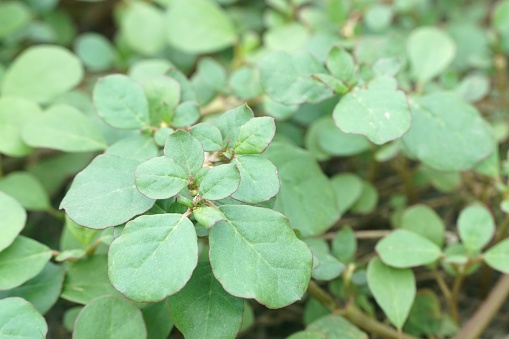

Trianthema portulacastrum L.
|
It is commonly known as Sabuni and belongs to the Aizoaceae family. Leaves are cooked as vegetable. Ecdysterone, Leptorumol, β-sitosterol, β-carotene are among some of the bioactive compounds found in this plant. Phenolic compounds like flavanoids (Gallic acid) and Lupeol decreased Nitric oxide (NO) production in mice colon due to pretreatment of ML (Meyna laxiflora) and TP (Trianthema portulacastrum). Mode of Consumption : Sauteed and fried |
| Plant Details | Agro-climatic Zone | Vernacular Names | Pictures |
| Scientific Name: Trianthema portulacastrum L. Family: Aizoaceae Martinov Class: Magnoliopsida Order: Caryophyllales Genus: Trianthema L. Fruiting Season: June- September Parts: Leaves |
|
Andhra Pradesh : Ambatimadu, Atikamamidi, Galijeru Bihar : Salasabuni, Sabuni, Vishakhapara, Lalsabuni, Santhi, Svet-sabun Chhattisgarh : Salsa Bhaji Delhi : Salasabuni, Sabuni, Vishakhapara, Lalsabuni, Santhi, Svet-sabun Haryana : Salasabuni, Sabuni, Vishakhapara, Lalsabuni, Santhi, Svet-sabun Jharkhand : Salasabuni, Sabuni, Vishakhapara, Lalsabuni, Santhi, Svet-sabun Karnataka : Muchchugoni, Pasalaesoppu Kerala : Pasalikeera Madhya Pradesh : Salasabuni, Sabuni, Vishakhapara, Lalsabuni, Santhi, Svet-sabun Maharashtra : Pundharighentuli Odisha : Sweta Puruni Punjab : Biskhapra, Itsit Rajasthan : Salasabuni, Sabuni, Vishakhapara, Lalsabuni, Santhi, Svet-sabun Tamil Nadu : Sharunnai, Shavalai, Shaaranaj Uttar Pradesh : Salasabuni, Sabuni, Vishakhapara, Lalsabuni, Santhi, Svet-sabun Uttarakhand : Salasabuni, Sabuni, Vishakhapara, Lalsabuni, Santhi, Svet-sabun West Bengal : Sabuni,Gadabani |
 Plant |
| Compound/Extract | Activity | Mode of Action | Marker/References |
| Gallic acid & Lupeol | Anti-inflammatory | Phenolic compound like flavanoids (Gallic acid) and Lupeol decreased Nitric oxide (NO) production in mice colon due to pretreatment of ML (Meyna laxiflora) and TP (Trianthema portulacastrum). | NO[2] |
| Ethanolic extract | Hepatoprotective | The ethanolic extract of T. portulacastrum showed a significant dose dependent (100 mg, 200 mg/kg p.o. 10×) protective effect against two well known hepatotoxins, viz. paracetamol and thioacetamide induced hepatotoxicity in albino rats. The plant extract completely prevented the toxic effects of paracetamol and thioacetamide on the above serum parameters. | [3] |
| Aqueous extract of whole plant | Antinociceptive, Anti-arthritic | Aqueous whole plant extract of Trianthema portulacastrum (AETP) produced time course inhibition of carrageenan-induced paw oedema with peak effect (50.60%) at 250 mg/kg as well as significant reduction in complete Freund’s adjuvant (CFA)-induced arthritis by 58.56%, on day 27 and arthritic index (26.84%). | [4] |
| Major Class | Metabolites (Content of bioactives: mg/100g Fresh Weight) |
| Carboxylic Acid | 3,4-Dimethoxy cinnamic acid: , p-Methoxybenzoic acid: [1] |
| Flavonoid | C-methylflavone: [1] |
| Phenol | Leptorumol: [1] |
| Phenolic acid | 5-Hydroxy-2-methoxybenzaldehyde: [1] |
| Phytosterol | Ecdysterone: , Stigmasterol: , β-sitosterol: [1] |
| Terpene | 3-Acetylaleuritolic acid: , Trianthenol: [1] |
| Effect | Observation | DOI |
| Disease | Formulation | Reference | Author | TKDL |
| Information from Wealth of India | Reference |
|
CSIR(1976).The Wealth of India, Raw materials,Vol.-X ,P.281-282, New Delhi, India |
| 4.2, 4.2.1, 4.2.1.1, 4.2.1.3, 4.2.2.8, 4.2, 4.2.1, 4.2.1.1, 4.2.1.3, 4.2.2.8 |
| CSIR-North East Institute of Science and Technology, Jorhat-6, Assam, India
CSIR-Institute of Himalayan Bioresource Technology, Palampur-61,Himachal Pradesh, India |